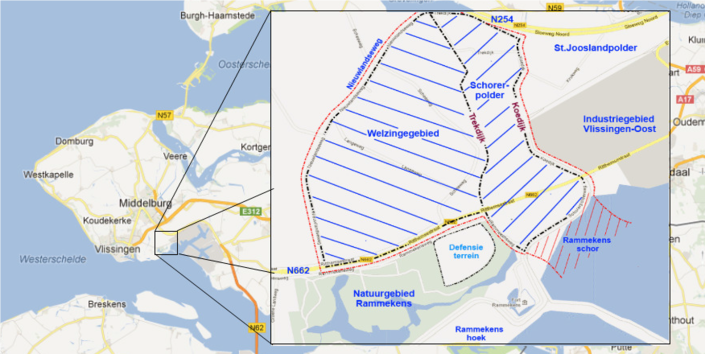Jointly understanding and validating the system and challenges
Inhoud
The area
Between the port of Vlissingen-East and the city region of Middelburg-Vlissingen lies an agricultural area including the Schorerpolder (figure 1). The owner, port authority North Sea Port, will use the polder as nature compensation for further port development. The idea is to bring the 50-hectare Schorerpolder back into contact with the sea and to create a low-dynamic, estuarine habitat which contributes to the nature objectives of the Western Scheldt estuary. This nature compensation was already discussed in 2003 for plans for a Western Scheldt Container Terminal directly outside the port, but this terminal was never realized. Now there is a plan for the construction of a new quay within the port and the nature compensation Schorerpolder is being discussed again.
Living lab
North Sea Port and nature conservation organizations united in Coalition Delta Natural CDN) are discussing the nature development in Schorerpolder. Four design variants for a future design were established through workshops and developed in terms of morphology and ecology (Tauw, 2017). However, many aspects are still unanswered. The design and use of such a new nature area requires expertise in many areas of knowledge and involvement of all parties in order to arrive at shared principles, knowledge sharing and supported choices. This is why this issue is an ideal subject for an integrated approach in which education, knowledge partners, governments and companies work together in a very current policy area. The following three activities take place:
1. stakeholder involvement
There are various methods to actively involve these stakeholders in the living lab and the co-creation process. Important steps include: raising awareness of each other's position, joint analysis of facts and problems, identifying relevant research questions and working towards on a shared vision. The choice of method is coordinated with the parties involved and partly depends on the phase in which the process is situated. Based on a structured questionnaire developed by Knowledge Center Expertise and Valorisation Management (KC EVM), students will visualize what is going on, who is involved and has a mandate, what the motivation for change is, etc. Living lab work sessions will be organized in which the existing knowledge and current applied research is discussed. Participants include Zeeland Seaports, CDN, HZ, research partners (Deltares, Wageningen Marine Research / WMR, NIOZ, etc.), business (PORTIZ, agriculture, etc.), government organizations (municipalities, waterboard etc) and citizens.
2. Civil engineering of vital infrastructure
Many technical challenges lay ahead to adjust the existing infrastructure. To allow the tide into the Schorerpolder dikes have to be realigned, roads need to be diverted and the harbor jetty in the mouth of the port needs to be modified. New and technical sound designs have to be developed that allow sufficient exchange of seawater into the area and the development of low dynamic intertidal habitats. This include:
- come up with cost-effective designs to divert the existing dikes, taking into account failure mechanisms of the flood defenses on site;
- Measures against salinisation: the consequences of the realignment of the coastline on groundwater and freshwater supply in the surrounding agricultural land will be mapped. The usefulness and necessity of measures to combat salinisation will be investigated;
- Redesign access roads for trucks, car, and bicycle or foot area to the port and surrounding area;
- Maintenance and reinforcement of historic hard structures.
Ecosysteem diensten inrichtingsvarianten
Er zal een verkenning worden uitgevoerd naar de ecosysteemdiensten die bij de verschillende inrichtingsvarianten kunnen ontstaan. Er zal worden aangesloten op participatieve toepassing van de Natuurlijk Kapitaal Nederland-methodiek die onlangs succesvol is toegepast door succesvol is toegepast (Franken, et al., (p. 12-14), 1 mei 2016) voor een multifunctionele dubbele keringszone in de pilot dijkversterking Eemshaven – Delfzijl. In het Living Lab Schorerpolder zal de methodiek worden toegepast op de vier inrichtingsvarianten (TAUW, 2016). De onderzoeksopdracht omvat aldus:
- Het karteren en herkennen van de huidige ecosysteemdiensten en het inschatten van toekomstige ecostysteemdiensten op basis van activiteit 2. Dit gebeurt met behulp van GIS en beschikbare ecotopenkaarten, etc.
- Het kwantificeren en waarderen van ecosysteemdiensten, waarbij gebruik wordt gemaakt van kentallen en veldwaarnemingen in het estuariene milieus. Daartoe wordt een inventarisatie gemaakt van actuele voorbeelden in de regio (ontpoldering Perkpolder, Rammegors, Plan Tureluur, Waterdunen,..). De mogelijkheden zullen worden onderzocht om de ecosysteemdiensten verder te verhogen door het toepassen van eco-engineering, het vergroten van de belevingswaarde en kansen voor zilte teelt. Daarnaast zal inzicht worden gezocht in relatie tussen de nieuwe habitattypen die ontstaan en de Natura 2000 status.
- Het afwegen en benutten van de waarde zoals in kaart gebracht binnen activiteiten 1 en 2. De kansen voor ecosysteemdiensten in de Schorerpolder zullen worden besproken tijdens de workshop in juni 2018 met betrokken partijen. Het doel is om de meerwaarde van een ecosysteemdienst-benadering in kaart te brengen en de bestaande inrichtingsvarianten daarop te scoren. Ook zal de consequentie van toekomstige Natura 2000 status van de natuurcompensatie worden bediscussieerd tegen het licht van toekomstige havenontwikkelingen.
Policy frameworks
Relevant policy frameworks, including Natura2000, Ambition 2030 Zeeland Seaports, Agenda of the Future (VNSC), Natuurnetwerk Zeeland (Province of Zeeland), the national programs Delta Program on Spatial Adaptation and Flood Protection Program (HWBP).
References
- North Sea Port, Stronkhorst, HZ, 19 januari 2018.
